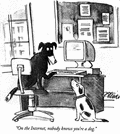 Writes Esther Dyson in the New York Times (link credit: Bret Fausett): What I'm proposing is not a rule-free society, but one in which rules come from the bottom up: generally enforced by peers, with governments in the background. ... The basic rule is transparency: You need to know whom you are dealing with, or be able to take proper measures to protect yourself.
Writes Esther Dyson in the New York Times (link credit: Bret Fausett): What I'm proposing is not a rule-free society, but one in which rules come from the bottom up: generally enforced by peers, with governments in the background. ... The basic rule is transparency: You need to know whom you are dealing with, or be able to take proper measures to protect yourself.
Unfortunately, the article essentially sets up anonymity and accountability online as contradictions. They need not be: The kind of accountability Esther describes is not so much about knowing who someone is in real life, but rather about recognizing a party you are dealing with (or knowing that you don't recognize a party seeking to communicate with you, and taking appropriate action). It's, often, not so much about linking on-line activity to real lilfe, but more often about linking current on-line activity to past on-line activity -- and, by symmetry, linking future on-line activity to current on-line activity.
This is so because for many activities online, stakes are actually quite low: To decide who's messages to read on mailing lists, or blogs, or slashdot -- or, in the past, Usenet --, for instance, it may quite well be enough to know that source's reputation among peers, or to have read earlier messages from that source. If something goes wrong, only littlel damage is done. All one needs to know to make this kind of choice is a regularly-used online pseudonym (most often, that's the e-mail address these days). If the same person uses a different pseudonym elsewhere, that's their business.
(Where the stakes are higher, reliable links to a person's online existence are, of course, useful.)
Accountability online is not a binary choice between total anonymity on the one hand, and total transparency with links to real life on the other: There is a broad spectrum between these, and often, the level of transparency and accountability that's needed will lie somewhere in between.
As a side note, all the accountability you can get won't fix viruses and similar security intrusions, unlike what Esther suggests: Just like the ordinary flu, successful online viruses often travel along the links in social networks.




